What is an acceptable level of risk?
Last week, I wrote about the practicality of the International Space Station (ISS) with regards to its financial cost. I concluded that not enough useful science is being done to justify the immense costs involved, and that the role of the ISS appears to be its function as a bench-warmer leading up to NASA's forthcoming Orion deep space capsule.
 Important things being done in the great cosmic outdoors. Image: NASA.
Important things being done in the great cosmic outdoors. Image: NASA.
But, in addition to the financial reasons, the presence of human beings on the ISS exacerbates its shortfalls as an orbital laboratory. At first glance, the science being conducted on the space station does not seem to justify the use of its human crew as glorified lab-rats.
If we're going to risk the lives of human beings in space, shouldn't we be using them for more important matters—like conducting actual space exploration?
THE ISS AS A DRESS-REHEARSAL FOR MARS
NASA has been claiming that the ISS is a crucial component in its preparation for one day landing humans on Mars. But that's sort of like assembling a bicycle and claiming that it's an important thing to do in order to prepare yourself for assembling a motorized car.
I mean, if your goal is to build a car that will get you from A to B, then why waste time building a bicycle at all? Either build the bicycle because you actually want to use it for something, or just skip it completely and get to work on the damn car!
Obviously, the ISS wasn't originally constructed for the purpose of going to Mars.
To oversimplify: during the Cold War, the Soviet Union built what amounted to a tricycle for toddlers in Low-Earth Orbit (LEO). The United States then tried to one-up them by building a full-fledged adult bicycle. When that proved too financially draining for one nation to accomplish alone, post-Soviet Russia and a bunch of other nations joined in to help. And that's how the International Space Station came to be.
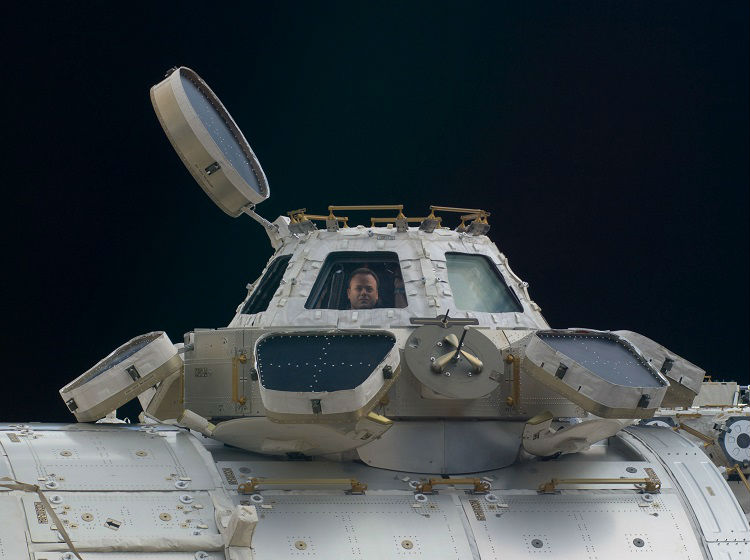 From here, one of the best views in the whole cosmos. Image: NASA.
From here, one of the best views in the whole cosmos. Image: NASA.
Now, NASA is playing it cool—as though the ISS (ie. the adult bicycle) was just a way to practice building something before going to Mars (ie. building their car).
But if that's the case, then it's an expensive bicycle. A lot of its parts were built custom, its carbon-fiber frame is subject to being damaged, it needs frequent maintenance, and there have been a few catastrophic failures along the way—one named Challenger, the other named Columbia. Between the two, 14 astronauts perished in the complete destruction of both spacecraft.
While not directly associated with the ISS, the Space Shuttle was originally designed to be a tool for use in on-orbit space station construction (it was unable to venture off into deep space, but had a large cargo bay for hauling freight). Had these 14 astronauts been traveling in top-mounted capsules (like Apollo) rather than on a side-mounted winged spacecraft (the only benefit of the wings was to allow the craft to land on a runway, but they led to enormous complications), none would have been killed in either incident.
Spaceflight is an inherently risk-laden endeavor, and if we're going to risk the lives of astronauts venturing out there, it should at least be for a good reason. By all metrics, the ISS is not a good enough reason. Today's astronauts are being exposed to all of the risks of space exploration, but with almost none of the rewards.
A RISK ANALYSIS OF THE ISS
Challenger exploded in 1986 as a result of faulty seals that became compromised in the cold weather launch conditions. Engineers had warned of the problem but were ignored by mission managers, who went ahead with the launch despite contractors who actually built the Space Shuttle warning them against doing so. The craft exploded some 15 kilometers above the launch pad.
 Challenger encounters catastrophe just 73 seconds into launch. Image: NASA/UPI.
Challenger encounters catastrophe just 73 seconds into launch. Image: NASA/UPI.
Columbia disintegrated during atmospheric re-entry in 2003. Because the shuttle was side-mounted, the craft's heat shield was damaged by foam falling off of the external tank during liftoff. Again, engineers warned of the potential problem and they were again ignored by mission managers who reasoned that, even if this were the case, there was nothing they could do about it.
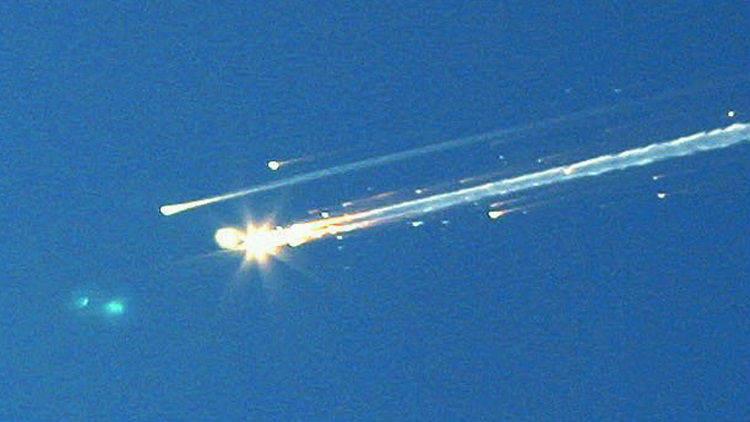 It's not a shooting star... It's Space Shuttle Columbia being destroyed... Image: Scott Lieberman.
It's not a shooting star... It's Space Shuttle Columbia being destroyed... Image: Scott Lieberman.
In neither case were the crew of the shuttles warned of any possible dangers. And despite warnings from knowledgeable high-ranking engineers, mission managers proceeded ahead as planned. After all, it wasn't their lives at stake. And they had mission schedules to keep.
These disasters brought to light the shortcomings in Space Shuttle risk analysis—a phenomena in which huge discrepancies emerge between perceived and actual levels of risk.
While the pre-Challenger probability of catastrophic failure and crew loss was officially pegged at one in 7,000 (that is, one disaster per 7,000 launches), engineers at NASA had internally estimated the real number to be somewhere in the 1 in 50 to 1 in 200 range. This huge divergence between mission managers and engineers shows the inherent shortcomings in realistic risk analysis and acceptance.
After Challenger, the risk probability was re-assessed to be 1 in 78—nearly a 100-fold increase in the accepted chance of losing both shuttle and crew. By the time of the Columbia disaster 17 years later (almost to the day), that umber had climbed as high as 1 in 254. The cosmic reality-check needed to be heard a second time.
Fortunately, there haven't been any fatal accidents directly related to the operation of the ISS. But there have been numerous close shaves. While orbiting Earth, the ISS has on a few dozen occasions found itself at risk of colliding with an object belonging to the ever-increasing amount of space debris. Over the years, the station has made about two dozen orbital adjustments in order to avoid what may have ended up being a catastrophic collision.
On four occasions, potential collisions were not detected in time to perform such a maneuver; astronauts had to be evacuated into docked Soyuz capsules, which serve as lifeboats in case of emergencies. In these situations, astronauts are prepared to abandon the station in the case that it sustains catastrophic and irreparable damage.
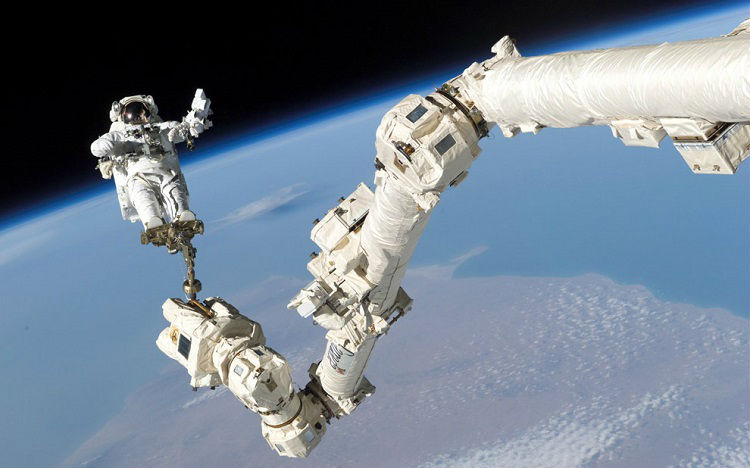 Despite what it may look like, this is a standard procedure. Image: NASA.
Despite what it may look like, this is a standard procedure. Image: NASA.
Luckily, all of these close shaves remained just that—close. And apart from a regular bombardment of micrometeors (rocks or dust weighing less than a gram but which can travel as fast as 10 kilometers per second relative to orbiting spacecraft) dinging the station and adding a few new dents to its exterior, no serious damage to the ISS has occurred so far. But, as we saw in both shuttle disasters, that doesn't mean that it won't happen.
Before the Space Shuttle was retired back in 2011, the average mission into LEO carried with it a 1 in 300 chance of being struck by space debris—not necessarily a catastrophic hit, but enough damage to cause real concern (largely due to the shuttle's fragile heat shield).
NASA does a decent job of tracking these potential collisions, and that involves keeping tabs on some 20,000 objects in various orbits around Earth. But they're only able to track objects that are softball-size or larger; there are millions of smaller objects only a few centimeters or smaller in diameter that our radar can't track.
Unfortunately, many of these smaller pieces of debris are still large enough that they could cause a huge problem if they were to impact a vulnerable area of the ISS or an orbiting spacecraft at a high enough velocity. And this is where the 1 in 300 comes from—objects large enough to be detected can be avoided, but these invisible and still dangerous objects can't be. And that's just an inherent risk of operating in LEO.
Then, of course, there are the spacewalks. There have been nearly 200 spacewalks as part of the construction and ongoing maintenance of the ISS. The closest an astronaut on a spacewalk has ever come to death happened as recently as 2013, when Italian ESA astronaut Luca Parmitano had to retreat back inside the station after his helmet began filling with water.
Parmitano was able to make it back inside of the space station without incident, but a giant blob of water had blocked his vision, obstructed his breathing, and disabled his communications devices—all while traveling hundreds of kilometers above the surface of the Earth at a speed of seven kilometers per second.
Up until that point, a flooding space helmet wasn't even thought of as a possibility. And if death-by-drowning isn't enough to worry about while out on a spacewalk, astronauts also need to worry about micrometeors, space suit ruptures, becoming detached from the station, a plethora of other spacesuit malfunctions, and any number of medical emergencies that could arise while venturing out into the great cosmic outdoors.
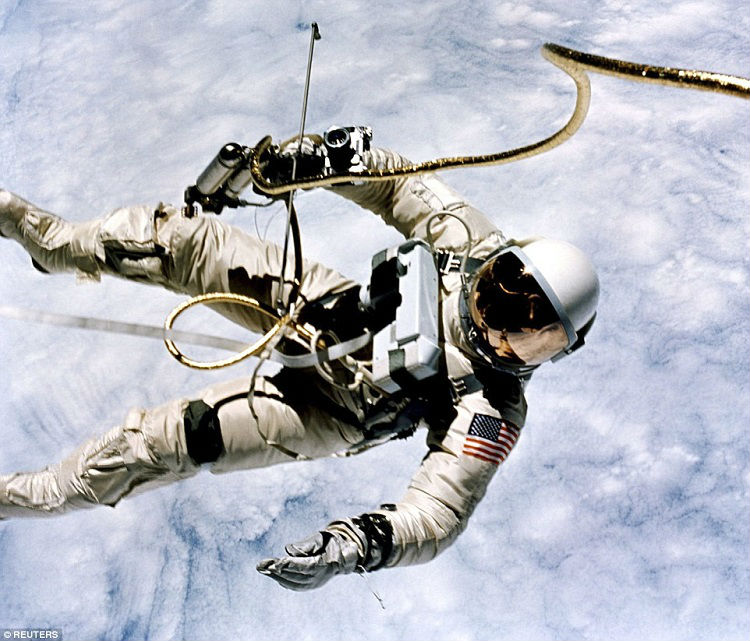 Human beings have been spacewalking since 1965; nobody has ever died while doing so. Image: NASA.
Human beings have been spacewalking since 1965; nobody has ever died while doing so. Image: NASA.
Despite these dangers, by all metrics the ISS has been a resounding success: no serious problems have occurred in 16 years of continuous operation. Even the need for such a high number of spacewalks to both construct and maintain the ISS was at one point considered impossible, referred to among experts as 'The Wall' that would prevent the station from ever being completed on a reasonable sort of time-frame.
Perhaps the most successful aspect of the ISS has been that it's made spaceflight look easy. As Elon Musk stated about the Falcon 9 rocket finally sticking the landing on SpaceX's floating barge, 'when the rocket landing becomes boring, that's when we'll know we've succeeded'. It's an example of the emerging phenomenon in which achievements that once seemed daunting gradually become commonplace (and even boring), all thanks to technological progress.
A similar thing happened with the ISS a long time ago. While there are many inherent risks in human spaceflight, a large portion of those are mitigated through meticulous astronaut training and a robust set of operational procedures. The result is that orbital spaceflight appears sort of boring—but that's only possible because the astronauts up there doing it are incredibly professional and really, really good at their jobs.
And while assembling a bicycle (like the ISS) may not be directly beneficial to the goal of one day assembling a car (going to Mars), there is something to be said about mastering the art of assembly in general. Sure, cars are a lot more complicated than bicycles. But in the act of assembling one, you learn techniques that are applicable to the other, such as: following directions, problem-solving, fundamental mechanical understanding, and most important of all, how to ride a bike.
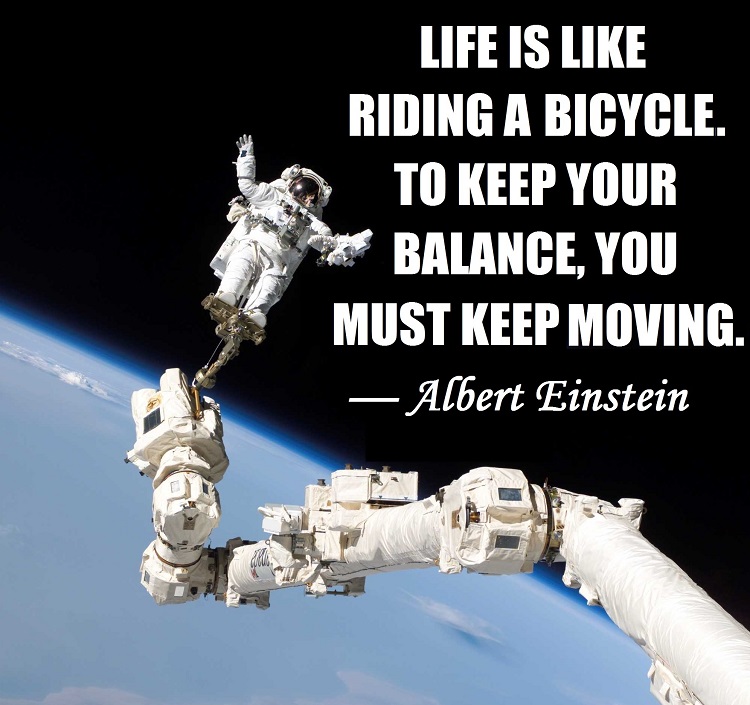 Not quite the way to get to Mars... But close enough.. Image: NASA, modified by Dan Levesque.
Not quite the way to get to Mars... But close enough.. Image: NASA, modified by Dan Levesque.
If we're going to one day put humans on Mars, it's probably wise to use the ISS as a stepping-stone. And if we want to keep our space-balance long enough to reach the red planet, we need to keep moving forward—even if, in this case, moving forward looks a lot like standing still in LEO.
ETHICAL ISSUES IN HUMAN SPACEFLIGHT
When considering the risks involved in any given space mission, we need to consider whether any given space exploration mission is worth undertaking in spite of those risks. For the Apollo missions, the answer was a resounding yes—the risks were there (the U.S. President even had a mission failure speech pre-written), but so were the vast gains to be had.
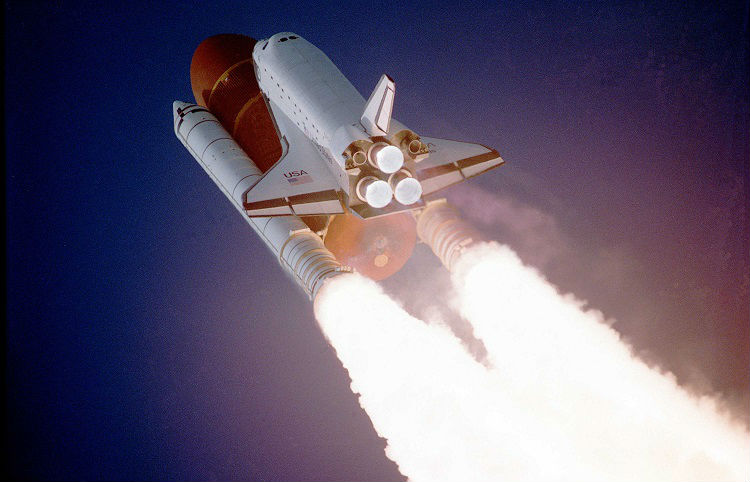 Space Shuttle Atlantis blasting into orbit in 1988. Fortunately, this one didn't explode. Image: NASA.
Space Shuttle Atlantis blasting into orbit in 1988. Fortunately, this one didn't explode. Image: NASA.
The Moon was the prize, and as Apollo 11 astronaut Buzz Aldrin remarked, "we had a 99% chance of survival, and the gain was enormous." The six successful missions to the lunar surface revolutionized human civilization and our perception of our own abilities. It's a high-water mark of scientific and technological achievement.
But the same may not be said of the ISS or the Space Shuttle. The gains simply aren't as profound or Earth-shattering. If we're going to take such a risk, t should be for good reason. As Aldrin also said of modern levels of risk compared to the Apollo era, "with the Space Shuttle, the gain is not as important."
Ask today's astronauts and their opinions will be clear. They're fine with visiting LEO if it's the only way they can go to space. But every one of them would much rather the opportunity of going to the Moon or Mars or anywhere in between.
We're also currently living in an age where robotic probes and rovers are conducting all of our most important space exploration activities remotely. In the 1969–1972 Apollo era, when humans wanted to study the surface geology of the Moon, we had to send human beings.
Today, we've had a world-class geologist on the surface of Mars for four years and counting: NASA's Curiosity rover. Equipped with a complete geological and chemical science laboratory, this robo-geologist on Mars is able to do most of the things that Apollo astronauts did on the Moon, but at a much slower pace and without the option of sample return (but that's not its fault; NASA hasn't even begun developing a Mars sample return rocket).
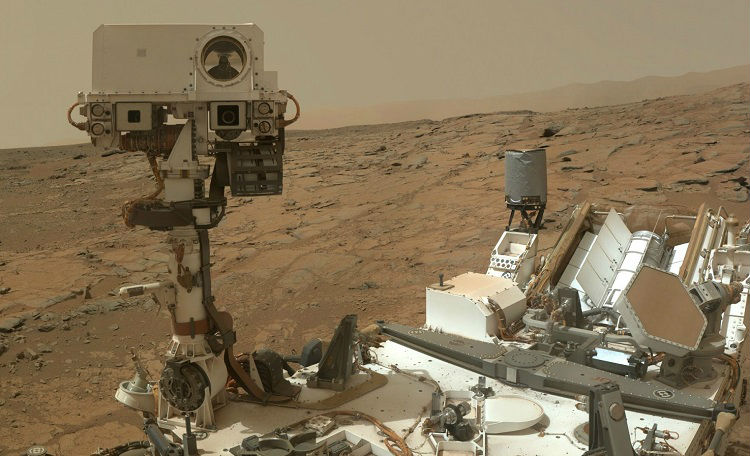 Behold, the greatest interplanetary geologist the world has ever known! Image: NASA/JPL-Caltech/MSSS.
Behold, the greatest interplanetary geologist the world has ever known! Image: NASA/JPL-Caltech/MSSS.
And the price-tag for Curiosity? $2.5 billion, which is less than the annual $3 billion of operating the ISS. And every year, exploration missions like Curiosity add significantly to our understanding of our Solar System. Operations on the ISS only teach us about how to conduct operations in space. And that's not an inherently bad thing, either. if our goal is to reach Mars, then we do need to get really, really good at spaceflight.
While the costs and risks associated with operating the ISS solely for the sake of having a space station don't quite add up, its impact on the future of human spaceflight needs to be factored in. The spaceflight knowledge-base gained through the construction and maintenance of the ISS will prove invaluable to NASA's long-duration Journey to Mars, and carrying that expertise forward may just end up being that X-factor that makes the journey possible.
Human beings still have an important role to play in the future of space exploration. Astronauts on Mars would be able to work much faster and more efficiently than Curiosity, and having just one human on the surface of Mars would be comparable to having a hundred different exploration rovers each with various capabilities.
Is it worth the risk in that case? I would think so. When astronauts do eventually travel to Mars, there will be quite a few ethical questions that go above-and-beyond basic risk-avoidance. Here's a brief list of topics that I couldn't possibly cover in one post:
- Does the accepted level of risk for any given space mission operate on a sliding scale? As in, do we accept a higher level of risk if the rewards are also higher? And if so, do we require lower risks for low-yield missions?
- How well informed should astronauts be about the probability of catastrophic failure for any given mission? And how involved should these astronauts be in the decision-making process (especially when any decision may significantly impact their immediate or long-term well-being)?
- Using Challenger and Columbia as examples, how much decision-making power should mission managers have? And how can we avoid repeats of these scenarios?
- From a planetary protection standpoint, are we justified in sending human beings to Mars? What if we contaminate the 'pristine' Martian environment with Earth microbes?
- What is the purpose of the human spaceflight program overall? Are we seeking to explore, to establish outposts, to colonize?
- How can we more accurately assess risks and mitigate them? How many redundant systems should be put in place to ensure the safety of a human crew? And if catastrophic scenarios do arise, should we have rescue plans ready-to-go?
- How much concern should we have for overall astronaut health? We know that long-duration stays in microgravity and exposure to cosmic and solar rays are damaging to human physiology, so what steps should be taken to mitigate these factors?
When it comes to the human factor of spaceflight, attempting to resolve important questions just leads to more questions. We're still infants on the cosmic stage. We're learning, we're getting better, but we still have a long way to go.



